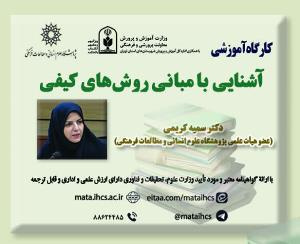Interactional Metadiscourse Markers in the Discussion and Conclusion Sections of the Research Papers in the Disciplines of Political Sciences and Religious Studies (مقاله علمی وزارت علوم)
درجه علمی: نشریه علمی (وزارت علوم)
آرشیو
چکیده
Metadiscourse is an essential component of academic writing, as it helps authors better communicate their ideas and engage their readers. It is through the analysis of the text's metadiscourse that one can explore academic writing and compare the rhetorical traits and preferences of various discourse communities (Hyland, 2005). To this end, this study examined the differences in the use, type, and frequency of interactional metadiscourse markers in the discussion and conclusion sections of political science and religious studies articles written in English language. The corpus of this study consisted of 45032 words extracted from fifty research articles, twenty-five articles in the field of political science, and twenty-five articles in the field of religious studies published between 2019 and 2023 in the top one high-impact factor and peer-reviewed international journals. To analyze the data, one Eta and two Chi-square tests were run. Considering the interactional resources of Hyland’s (2005) metadiscourse model, the researchers uncovered that despite some subtle differences in the use, frequency, and types of these metadiscourse markers, “hedges” were the most and attitude markers were the least frequently used metadiscourse markers employed in both political science and religious studies disciplines. The findings have some educational implications that shed light on the need to encourage English language teachers, university professors, and publishers in the fields of TEFL and ESP to provide EFL learners with appropriate sources and settings to increase their familiarity with various metadiscourse markers, especially the category of interactional MDMs that aids them write coherently and establish genuine interaction with audiences.نشانگرهای فراگفتمان تعاملی دربخش های بحث و نتیجه گیری مقالات پژوهشی در حوزه های علوم سیاسی و مطالعات دینی
فراگفتمان یکی از اجزای ضروری در نوشتار آکادمیک است، به این سبب که به نویسندگان کمک می کند تا ایده های خود را بهتر انتقال دهند و خوانندگان خود را درگیر نمایند. از طریق تحلیل فراگفتمان متن است که می توان نوشتار آکادمیک را بررسی کرد و ویژگی های بلاغی و ترجیحات جوامع گفتمانی گوناگون را با هم مقایسه کرد (هایلند، 2005). به این منظور، این پژوهش به بررسی تفاوت ها در استفاده، نوع و فراوانی نشانگرهای فراگفتمان تعاملی در بخش های بحث و نتیجه گیری مقاله های علوم سیاسی و مطالعات دینی نوشته شده به زبان انگلیسی پرداخته است. پیکره این پژوهش شامل 45032 واژه استخراج شده از پنجاه مقاله پژوهشی، بیست و پنج مقاله انگلیسی در حوزه علوم سیاسی و بیست و پنج مقاله انگلیسی در حوزه مطالعات دینی است که بین سال های 2019 تا 2023 در مجله های ممتاز و معتبر بین المللی چاپ شده اند. برای تجزیه و تحلیل داده ها، یک آزمون اتا و دو آزمون کای دو اجرا شد. با در نظر گرفتن منابع تعاملی مدل فراگفتمان هایلند (2005)، نگارندگان دریافتند با وجود برخی تفاوت های ظریف در کاربرد، فراوانی و انواع این نشانگرهای فراگفتمانی، «تردیدنماها» بیشترین و نشانگرهای نگرش کمترین استفاده از نشانگرهای فراگفتمانی را در هر دو رشته علوم سیاسی و علوم دینی داشتند. یافته های این پژوهش می تواند به ارائه منابع کافی و ایجاد موقعیت های مناسب به دانشجویان زبان انگلیسی برای افزایش آشنایی آن ها با نشانگرهای فراگفتمانی مختلف به ویژه در حوزه نشانه های فراگفتمانی تعاملی کمک نماید تا آن ها بتوانند منسجم بنویسند و تعاملی واقعی با مخاطبان داشته باشند.







